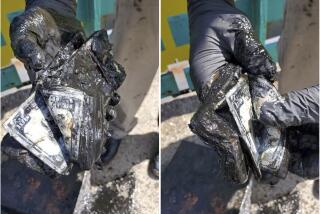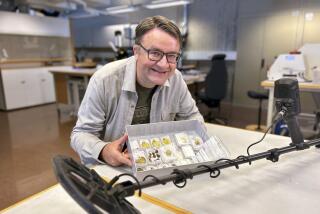The Chill of the Hunt
- Share via
ST. PAUL, Minn. — It’s long past midnight, three degrees below zero, and two guys in camouflage parkas are scrambling through a tangle of frozen brambles on a hill in a pitch-black park. Down by the river, young lovers so bundled only their eyes show rake dead leaves in a stinging wind.
Two men sift through the sand of a gloomy playground. Two others pace off a soccer field. Across the park, yellow circles bob and waver -- flashlights picking out clods of mud and crumpled candy wrappers. It’s silent, except for the scrape of hoes.
The great treasure hunt is on.
Thousands of men, women and children, many with headlamps strapped around wool hats, drive themselves into a frostbitten frenzy each January in search of a blue plastic medallion. The medallion is worth $10,000, plus a trip for two to Hawaii. That’s incentive to get out and dig. But the prize money doesn’t begin to explain the medallion mania that grips this city.
A rite of winter since 1952, the treasure hunt has become a civic institution in the Twin Cities. Parents give 3-year-olds spoons to poke through snowdrifts. Whole families -- sometimes three generations -- abandon work and school to scour parks. Some take a week’s vacation so they’ll have more time to search.
“I break from reality completely,” said Tami Cormier, 36, a mother of three. “I don’t cook. I don’t do laundry. I don’t sleep. My kids survive on frozen pizza and fish sticks.”
The most obsessive, wrapped in so many layers they can barely bend their knees, search 12, 16, 20 hours a day, their teeth unbrushed, their hair matted. They give themselves nicknames like “Excavator Stud” and form teams like the “Maidallions” -- three women who own a housecleaning service.
They pore over worn copies of the Treasure Hunter’s Guide, a book that maps every tree, every dumpster, every memorial bench in every park in St. Paul. (Steve Worthman, an avid hunter who wrote the guide, spent five years on it. “I’m not normally the kind of guy who engages in obsessive behavior. Except for this,” he said, shortly after putting out his second edition in 1999. )
The hunt is sponsored by the St. Paul Pioneer Press, and the newspaper prints a cryptic clue to the treasure’s location daily until the medallion is found -- which can take anywhere from five to 12 days.
As they close in on the medallion, hunters line up by the hundreds outside the Pioneer Press lobby, standing for hours in brutal cold to grab the first edition when it comes off the press at 11 p.m. rather than wait for the clue to appear online at midnight. On walkie-talkies or cell phones, they bark the clue to buddies positioned in the field, then race to join them. They know it’s nutty. They cannot stop.
“The medallion is so elusive, it’s like a mythical object. It would be just a transcendental experience to find it, to get to hold it,” said Randy Skjerly, a 50-year-old proofreader who has been hunting for a decade without luck.
“I’m exhausted. I’m so sore, I can barely move. I hate this. But I’m hooked,” Dale Coski said earlier this week, after a long night of searching.
Tiny icicles glinted on his eyelashes. Burrs clung to his blue ski mask. Coski’s nose was scratched from branches that had lashed his face as he hunted in the dark. It was noon now, on a cheerless gray day, and he was scratching through the grassy median in a parking lot. He had told his boss at the post office that he had a bug. “I got medallion fever,” said Coski, 38.
The medallion is hidden on public property in St. Paul or in the surrounding county by a top-secret team at the Pioneer Press -- in recent years, two reporters, who also write the rhyming clues, laced with puns and anagrams and local history.
Even publisher Harold Higgins claims not to know who hides the treasure, much less where it is. He does know that the paper’s circulation of 190,000 jumps by a few thousand during the hunt. And that the secrecy makes the game of deciphering clues “a whole lot more fun.”
“My typical answer, when people ask, is that there are leprechauns involved,” he said.
For their part, the clue writers are not about to spill the beans. Don Boxmeyer, a retired Pioneer Press columnist, hid the treasure under cover of night for seven years in the 1990s -- and watched with secret pleasure as some of his best friends puzzled for hours over his clues, attaching enormous significance to words he had thrown in just to make a rhyme.
If they were getting too close, he revised the next clue to throw them off course. If they were hopelessly confused, he took pity, loading the next day’s verse with hints.
Unraveling the clues is only the first challenge. Over the years, the medallion has been hidden in a sock, in a fast-food burger box and in a discarded (but mercifully, clean) diaper. It’s been taped to a broken record and an Oreo cookie, even stuck into the crevice of a boulder. One year it was wrapped in green-and-brown Play-Doh, making it look like dog droppings.
Often, medallion seekers must dig through chest-high snowdrifts to find the prize. This year, with the snow a disappointing no-show, they toted rakes, potato hoes, even leaf-blowers from park to park instead of shovels. The medallion may be hidden under feet of debris, but it’s never buried underground.
As they search, hunters often swap interpretations of the clues. “Noodling,” they call it.
“You’re out in a park in the middle of the night, in a wooded area and you’re talking to a total stranger. Where else in America could you do that?” said Terry Knapp, 56, who has been a fanatical hunter since his mother dragged him out to dig in the snow when he was 4.
This year, he turned down a free trip to the Super Bowl in a private jet to rake through leaves in a wind-chill of 15 below. “I mean, c’mon. I’m going to be sitting out there in San Diego when the medallion hunt is going on?” he said.
A self-employed salesman, he’s lost more income over the years than he could hope to make up by finding the medallion. The hunt, he insists, is not about money. It’s about community. Officials cannot recall any fights during the hunt although police patrol the parks more frequently just in case.
“You’d think it would be a battle royal out there,” Knapp said, “but it’s amazing how much you start sharing.”
Hunters stumble home at 3 a.m. only to spend hours dissecting the latest clue in Internet chat rooms.
Friends think nothing of calling each other in the middle of the night to suggest searching a particular drainpipe.
“You can’t keep your mind off it,” said Betty Jo Ward, 34, who hunts with her mom and her sister.
This year’s clues offered plenty to noodle over.
No one could get a bead on Clue 3, which read: “Wide as Triple E, our door will always be, open to all who enter.” Was Triple E a shoe size? An allusion to Cherokee Park? A tip to search near the boat docks on the Mississippi River, which are shaped a bit like the letter E? The clue actually referred to a stone entrance to Como Park donated by E. E. Englebert.
“The coldest star will guide you far,” Clue 4, spurred Rus Meyers, 53, to pry up rocks by the riverbank, on the theory that the coldest star was a meteor fallen to earth. He wore out three pairs of gloves by dawn.
A line in Clue 8 -- “lure me precious to your soul” -- had Ward hunting near a bait shop. A reference in Clue 9 to the “search for truth” sent Knapp to the intersection of Plato Street and an avenue named for a local judge.
Maddeningly ambiguous, the clues in the first week directed many hunters to Harriet Island, a vast park by the Mississippi. When Clue 11 came out Tuesday night, they realized they had been wasting their blisters. That verse made it clear the medallion was hidden in Como Park, several miles north of the river.
It took Clue 12 -- which suggested a search 40 paces north of the fire pit -- to solve the mystery. Three young men found the medallion, encased in ice, just before midnight Wednesday.
Disappointed hunters are already longing for next year.
“I will be doing this for the rest of my life. I guarantee it,” said Shaun Fleming, 18.
“There’s nothing like this in the world,” said Jake Ingebrigtson, 24, a college student who skipped two weeks of classes to roam the streets in a van he has dubbed the “Medallionator.”
(It pulls up to the Pioneer Press lobby in the evenings blaring the theme from “Rocky.”)
Ingebrigtson has memorized clues going back decades and is prone to saying things like: “This might be a reference to Phalen Park ’83.”
To which a stranger in line behind him for the newspaper is apt to respond: “Yeah, it reminds me of Clue 11.”
To the intense irritation of guys like Ingebrigtson, such devotion to the hunt does not guarantee success. Many casual treasure seekers don’t bother with the clues; they just wait until they hear on the radio that throngs have invaded a particular park, and head over to join the digging. Sometimes, they stumble across the medallion by chance.
Last year, a 16-year-old kicking at leaves by a baseball field found the treasure after six clues. He had been hunting, somewhat aimlessly, for just 20 minutes. That abrupt end to the hunt so infuriated a group of die-hard treasure fans that they staged their own medallion quest a few weeks later, putting up $500 from their own wallets for a prize.
Those who have found the real medallion are regarded with awe bordering on reverence.
When Ingebrigtson dared refer to a longtime hunter, Bill Gralish, as “wrong-park Bill,” two people standing nearby interrupted to remind him that Gralish found the puck in ’69. They prefer to call him Winnebago Bill, because he camps out in an RV during the hunt.
“He let me stand in his RV when I was hunting on my birthday, and it was the best birthday present I ever had,” Cathi Hogan said.
That same day, during the ’01 search, another past winner showed her the white sock that held the medallion in ’98. “He let me hold it! It was like, ‘Oh, my God!’ ” Hogan squealed. It apparently brought her luck: She found the medallion the next day.
A kindergarten teacher, Hogan, 45, buries pennies in snow in her classroom so her students can experience the thrill of the hunt.
Intrigued by that level of obsession, New York filmmaker Trent Tooley has come to St. Paul three years running to shoot a documentary on the chase for the medallion.
The working title: “No Time for Cold Feet.”
More to Read
Sign up for The Wild
We’ll help you find the best places to hike, bike and run, as well as the perfect silent spots for meditation and yoga.
You may occasionally receive promotional content from the Los Angeles Times.






